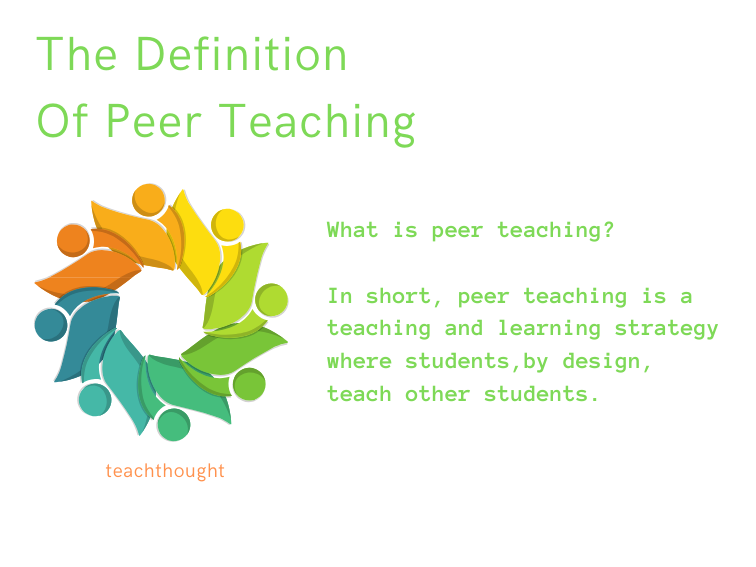The Definition Of Peer Teaching: A Sampling Of Existing Research
Peer teaching occurs when students, by design, teach other students.

Peer Teaching: A Definition
by TeachThought Staff
What is peer teaching?
In short, peer teaching occurs when students, by design, teach other students.
But teaching what? And how? Austin Community College provided an overview of some of the existing (though decades old) research in a collection of resources for teachers in training, which provides a nice context for peer teaching.
“There is a wealth of evidence that peer teaching is extremely effective for a wide range of goals, content, and students of different levels and personalities (McKeachie et al., 1986). Peer teaching involves one or more students teaching other students in a particular subject area and builds on the belief that “to teach is to learn twice” (Whitman, 1998).”
“Peer teaching can enhance learning by enabling learners to take responsibility for reviewing, organizing, and consolidating existing knowledge and material; understanding its basic structure; filling in the gaps; finding additional meanings; and reformulating knowledge into new conceptual frameworks’ (Dueck, 1993).”
“Help from peers increases learning both for the students being helped as well as for those giving the help. For the students being helped, the assistance from their peers enables them to move away from dependence on teachers and gain more opportunities to enhance their learning. For the students giving the help, the cooperative learning groups serve as opportunities to increase their own performance. They have the chance to experience and learn that “teaching is the best teacher” (Farivar and Webb, 1994).”
In lieu of the benefits peer teaching and learning provide, it has a mixed reputation in education to its abuse via ‘let the ‘high’ students teaching the ‘low’ students’ which, done poorly, fails to meet the needs of both.
Peer Learning
David Boud of Stanford University explored the concepts of peer teaching, learning, and reciprocal peer learning in a short overview of existing research–which is limited. Though the context he discusses is primarily in the higher-ed domain where peer teaching is a literal component of most university learning models, the concepts transfer to K-12 as well.
According to Boud, peer learning is obviously closely related,
“We define peer learning in its broadest sense, then, as ‘students learning from and with each other in both formal and informal ways’. The emphasis is on the learning process, including the emotional support that learners offer each other, as much as the learning task itself. In peer teaching the roles of teacher and learner are fixed, whereas in peer learning they are either undefined or may shift during the course of the learning experience. Staff may be actively involved as group facilitators or they may simply initiate student-directed activities such as workshops or learning partnerships.”
As for the limited research data, Boud continues,
‘According to Topping’s review of literature, surprisingly little research has been done into either dyadic reciprocal peer tutoring or same-year group tutoring (Topping, 1996). He identified only 10 studies, all with a very narrow, empirical focus. This suggests that the teaching model, rather than the learning model, is still the most common way of understanding how students assist each other. Although the teaching model has value, we must also consider the learning process itself if we want to make the best use of peers as resources for learning.”
Whitman and Fife (1989) summarize research that was to that point current, below.
“Recommendations from current literature include the following: learning may occur when students work cooperatively, both peer teachers and peer learners learn, and learning may increase with a blend of situations in which professors are present and are not present.”
A significant portion of existing discourse on peer teaching relate to its application in the medical field, or language learning. A study published at Oxford Academic’s ELT Journal in 2017 added little new information, with the abstract concluding, “The use of peer teaching in the language classroom offers a creative way for students to participate more fully in the learning process,” and alluding to “(p)revious studies (that) have reported that peer taught lessons bring benefits such as improved motivation, enhanced learning, and authentic communication.”
The Definition Of Peer Teaching: A Sampling Of Existing Research
